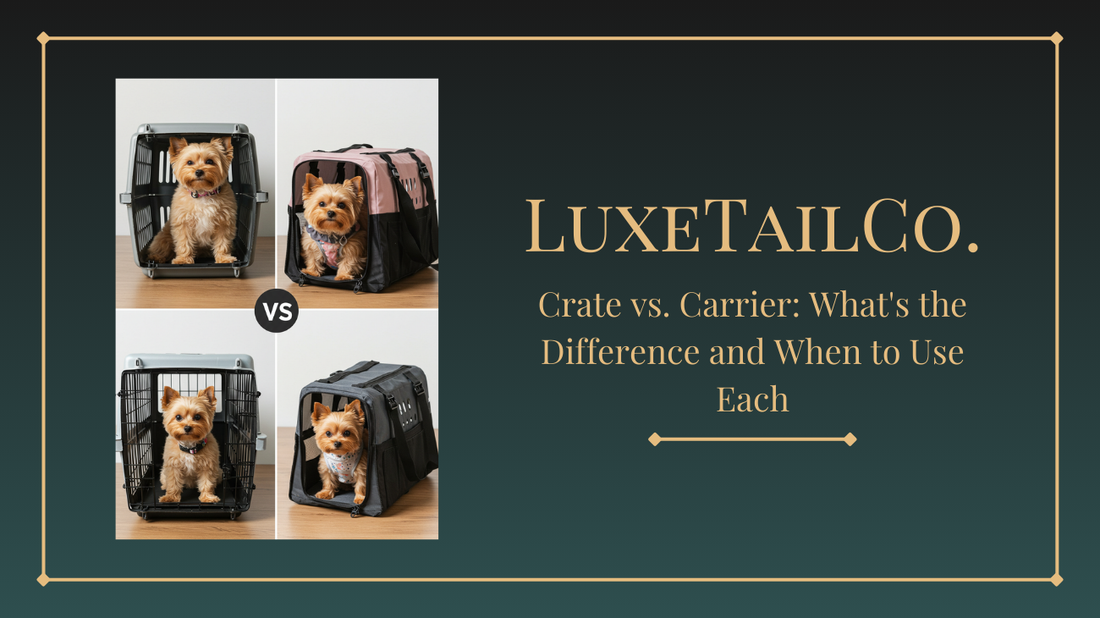
Crate vs. Carrier: What's the Difference and When to Use Each
Share
Introduction
Choosing between a crate and a carrier can be confusing for pet owners, especially with so many options available. While both are designed to contain and protect your pet, they serve distinct functions and are suited for different situations. In this guide, we break down the differences between crates and carriers, when to use each, and how to make the best choice based on your pet's needs.
What is a Pet Crate?
A pet crate is a larger, more durable enclosure used primarily for home use and training. Typically made from metal, plastic, or heavy-duty fabric, crates are designed to give pets their own space and to help with housebreaking and anxiety.
Key Features:
- Roomy and spacious for long-term use
- Often foldable or collapsible for storage
- Ideal for crate training and behavioral management
- Commonly used indoors
- Available in wire, plastic, or soft-sided designs
Best For:
- Dogs of all sizes
- Long periods of confinement (with breaks)
- House training
- Creating a safe space for your pet
What is a Pet Carrier?
A pet carrier is a smaller, portable enclosure used for transporting pets, especially cats and small dogs. Carriers are usually made from plastic, fabric, or leather, and they prioritize lightweight design and convenience.
Key Features:
- Compact and easy to carry
- Comes with handles, straps, or wheels
- Often airline-approved
- Typically enclosed for added security
- Soft-padded or hard-sided options available
Best For:
- Small dogs, cats, rabbits, and other small animals
- Travel (car, plane, or public transport)
- Vet visits and short trips
- Keeping pets secure while on the go
Crate vs. Carrier: Key Differences
| Feature | Crate | Carrier |
|---|---|---|
| Size | Larger, suitable for long-term use | Compact, travel-friendly |
| Purpose | Training, sleeping, home use | Transportation, short-term containment |
| Material | Wire, plastic, or heavy fabric | Plastic, fabric, or leather |
| Portability | Less portable, though some are collapsible | Highly portable and lightweight |
| Ventilation | Excellent, especially in wire crates | Varies; soft-sided often well-ventilated |
| Comfort | Can be customized with bedding | Padded interiors for short-term comfort |
When to Use a Crate
- Training a Puppy or Rescue Dog: Crates are ideal for teaching house rules and providing a sense of security.
- Nighttime Sleeping: Crates help pets settle down and reduce nighttime anxiety.
- When Leaving Home Temporarily: Crating your pet can prevent destructive behavior and keep them safe.
- Creating a Safe Zone: Crates act as a pet's personal sanctuary.
When to Use a Carrier
- Trips to the Vet: Easy to transport and provides a safe, enclosed space.
- Airline or Road Travel: Carriers are designed to be secure and meet travel regulations.
- Emergency Situations: Quick and easy to grab, carriers are essential for evacuation or urgent trips.
- Public Places: Keep your pet safe in crowded areas or on public transport.
Tips for Choosing the Right One
- Consider Your Pet’s Size & Breed: Larger pets usually need crates, while small breeds or cats do better with carriers.
- Think About Your Lifestyle: Are you often on the go, or does your pet spend more time at home?
- Prioritize Ventilation & Comfort: Look for mesh panels or open sides for airflow.
- Check for Safety Features: Locks, zippers, and secure latches are a must.
- Don’t Forget Style & Ease of Cleaning: Especially important for regular use!
Conclusion
Choosing between a pet crate and a carrier isn’t about picking the best overall, but selecting what works best for your lifestyle and your pet’s needs. Crates are great for training and home use, while carriers shine when it comes to transport and short trips. Understanding the purpose of each can help you invest in the right accessory for a safer, happier pet. 🐾
